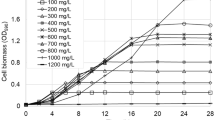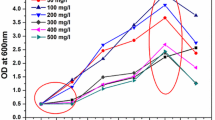Abstract
A modeling study was conducted on growth kinetics of three different strains of Pseudomonas spp. (Pseudomonas aeruginosa, Pseudomonas fluorescens, Pseudomonas putida) during benzene degradation to determine optimum substrate concentrations for most efficient biodegradation. Batch tests were performed for eight different initial substrate concentrations to observe cell growth and associated substrate degradation using benzene-adapted cells. Kinetic parameters of both inhibitory (Haldane–Andrews, Aiba–Edwards) and noninhibitory (Monod) models were fitted to the relationship between specific growth rate and substrate concentration obtained from the growth curves. Results showed that half-saturation constant of P. fluorescens was the highest among the three strains, indicating that this strain could grow well at high concentration, while P. putida could grow best at low concentration. The inhibition constant of P. aeruginosa was the highest, implying that it could tolerate high benzene concentration and therefore could grow at a wider concentration range. Estimated specific growth rate of P. putida was lower, but half-saturation constant was higher than those from literature study due to high substrate concentration range used in this study. These two kinetic parameters resulted in substantial difference between Monod- and Haldane-type models, indicating that distinction should be made in applying those models.




Similar content being viewed by others
References
Abuhamed T, Bayraktar E, Mehmetolu T, Mehmeto U (2004) Kinetics model for growth of Pseudomonas putida F1 during benzene, toluene and phenol biodegradation. Process Biochem 39:983–988
Aiba S, Shoda M, Nagatani M (1968) Kinetics of product inhibition in alcohol fermentation. Biotechnol Bioeng 10:845–856
Alvarez PJJ, Anid PJ, Vogel TM (1991) Kinetics of aerobic biodegradation of benzene and toluene in sandy aquifer materials. Biodegradation 2:43–51
Andrews JF (1968) A mathematical model for the continuous culture of microorganisms utilizing inhibitory substrates. Biotechnol Bioeng 10:707–723
D’adamo PD, Rozich AF Jr, Gaudy AF (1984) Analysis of growth data with inhibitory carbon sources. Biotechnol Bioeng 26:397–402
Edwards VH (1970) The influence of high substrate concentration on microbial kinetics. Biotechnol Bioeng 12:679–712
Guha S, Jaffe PR (1996) Determination of Monod kinetic coefficients for volatile hydrophobic organic compounds. Biotechnol Bioeng 50:693–699
Haldane JSB (1930) Enzymes, longmans, green, UK. Republished by MIT Press, Cambridge, MA (1965)
Kelly WR, Hornberger GM, Herman JS, Mills AL (1996) Kinetics of BTX biodegradation and mineralization in batch and column systems. J Contam Hydrol 23:113–132
Kim DJ, Choi NC, Lee NN, Mahendran B (2005) Effect of glucose on benzene degradation by Pseudomonas spp. J Appl Microbiol (submitted for publication)
Kovarova-Kovar K, Egli T (1998) Growth kinetics of suspended microbial cells: from single-substrate-controlled growth to mixed-substrate kinetics. Microbiol Mol Biol Rev 62:646–666
Monod J (1949) The growth of bacterial cultures. Annu Rev Microbiol 3:371–394
Oh YS, Shareefdeen Z, Baltzis BC, Bartha R (1994) Interactions between benzene, toluene, and p-xylene (BTX) during their biodegradation. Biotechnol Bioeng 44:533–538
Reardon KF, Mosteller DC, Rogers JDB (2000) Biodegradation kinetics of benzene, toluene and phenol as single and mixed substrate for Pseudomonas putida F1. Biotechnol Bioeng 69:385–400
Rozich AF, Colvin RJ (1985) Effects of glucose on phenol biodegradation by heterogeneous populations. Biotechnol Bioeng 28:965–971
Rozich AF, Gaudy AF, D’adamo PD (1983) Predictive model for treatment of phenolic wastes by activated sludge. Water Res 17:1453–1466
Rozich AF, Gaudy AF, D’adamo PD (1985) Selection of growth rate model for activated sludges treating phenol. Water Res 19:481–490
Schirmer M, Butler BJ, Roy JW, Frind EO, Barker JF (1999) A relative-least-squares technique to determine unique Monod kinetic parameters of BTEX compounds using batch experiments. J Contam Hydrol 37:69–86
Tan Y, Wang Z, Marshall KC (1996) Modeling substrate inhibition of microbial growth. Biotechnol Bioeng 52:602–608
Vrionis HA, Kropinski MA, Daugulis AJ (2002) Enhancement of a two-phase partitioning bioreactor system by modification of the microbial catalyst: demonstration of concept. Biotechnol Bioeng 79:587–594
Acknowledgements
This work was supported by the Korea Research Foundation (grant no. KRF-2004-005-C00060).
Author information
Authors and Affiliations
Corresponding author
Rights and permissions
About this article
Cite this article
Kim, DJ., Choi, JW., Choi, NC. et al. Modeling of growth kinetics for Pseudomonas spp. during benzene degradation. Appl Microbiol Biotechnol 69, 456–462 (2005). https://doi.org/10.1007/s00253-005-1997-z
Received:
Revised:
Accepted:
Published:
Issue Date:
DOI: https://doi.org/10.1007/s00253-005-1997-z




